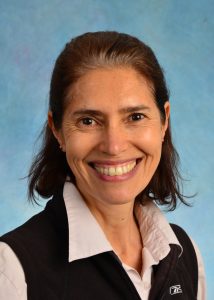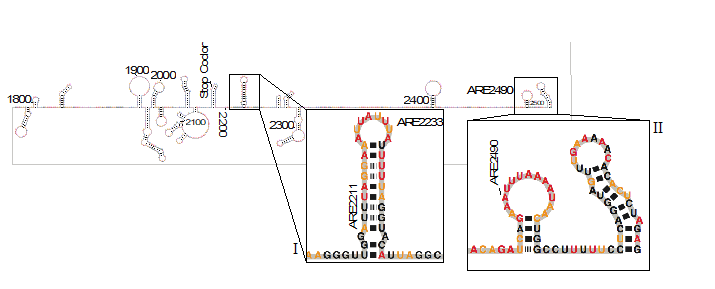Congratulations to Silvia B. Ramos, Associate professor of Biochemistry and Biophysics, effective Oct. 1st, 2020.

Dr. Ramos received her MD degree in Brazil in 1988 and became a board-certified rheumatologist in 1991. She then received a master’s in immunology and PhD at the University of São Paulo in Brazil in 1994 and 1998, respectively. She subsequently moved to the US to pursue postdoctoral studies in the laboratory of Dr. Perry Blackshear at NIEHS. While there, she developed her research interests in RNA biology and its role in female reproductive biology. Specifically, she established a key role for the RNA binding protein ZFP36L2 in mouse ovarian infertility – the findings of which have become a major area of research for her at UNC.
In 2014, Dr. Ramos joined the Department of Biochemistry and Biophysics under the mentorship of Dr. William Marzluff. Dr. Ramos pursues her passion of understanding the function of RNA-binding proteins and on making discoveries in this area with potential use for health care. She investigated the role of ZFP36L2 from her earlier work from NIEHS and made several key new findings that led her to publish an important paper in J. Biol. Chem. in 2012 that showed how ZFP36L2 is essential for early embryonic development; this finding formed the basis of a K08 award application that was successfully funded. During this award, Dr. Ramos continued to investigate ZFP36L2 in development and infertility, but also has expanded her studies focused on the structural basis of ZFP36L2-mRNA interactions and novel physiological roles of ZFP3L2. This new direction in understanding how ZFP36L2 functions at the structural level has naturally developed due to the fact that UNC is a hub for RNA biochemistry. This environment, which has been extremely supportive, has allowed her to move into new directions and obtain a great deal of support through internal and outside collaborations.
Dr Ramos’ work has led to multiple co-authorships in top-tier journals. For example, she recently published a paper in the RNA Journal that defined, at a structural level, why only one of the three adenylate-uridylate-rich elements (AREs) within the 3′ untranslated region of murine luteinizing hormone receptor (Lhr) mRNA can bind with the disrupting protein, ZFP36L2. Her data have determined that this interaction is governed by specific sequence recognition of the ARE motifs in the Lhr 3’ UTR. In addition, a critical component of these regulatory interactions is the structural context of the ARE motif. The ARE sequence and accessibility jointly mediate ZFP36L2 binding ability. These RNA structures (see Figure 1) were accurately characterized using the chemical RNA structure probing technique known as SHAPE-MaP (Selective 2’ Hydroxyl Acylation with Primer Extension coupled with Mutational Profiling). Her work also demonstrated that this occurs in the human system as well as mouse at the biochemical level, raising the interesting possibility that L2 has important implications for human fertility. Her most recently published article in Frontiers of Immunology this year, has shown that ZFP36L2 functions as an anti-inflammatory modulator – thereby implicating ZFP36L2 as a potential therapeutic target for autoimmune diseases. Her ongoing research is gaining national attention, as exemplified by an invited NSF Talk Award at a recent FASEB RNA Decay meeting.
In addition to her research, Dr. Ramos has been making key contributions on the side of service and teaching at UNC. At the School of Medicine, she leads multidisciplinary small group classes in the new Translational Education at Carolina (TEC) curriculum. She also participates on 395Bio and 395Chem that provides lab experience to undergrad students. Dr. Ramos developed during the Academic Career Leadership Academy in Medicine (ACCLAIM), a leadership development program with emphasis on those underrepresented minorities in medicine, a project that led to the creation of a new four year Scholarly Concentration Program for the Medical Students called MESSAGE (Medical Education Supporting Sexuality And Gender Expressions, https://www.med.unc.edu/md/curriculum/primary-care-programs-and-scholarly-tracks/scholarly-concentration-program/medical-education-supporting-sexuality-and-gender-expressions-message/), providing the first program of its kind on LGBTQ+ (Lesbian, Gay, Bisexual, Transgender, Queer/Questioning, and others) and DSD (differences in sexual development) health care at the UNC School of Medicine.
Dr Ramos serves on the HSAC (Honor System Advisory Committee) since 2017 and was reappointed for a second term in 2020. Dr Ramos is currently the vice-president of the APWIMS (Association for Professional Women In Medical Science, https://www.med.unc.edu/facultyaffairs/apwims/meet-our-vice-president/). Recently, Dr. Ramos has enthusiastically embraced the role of Diversity Liaison for our department (https://www.med.unc.edu/biochem/diversity-and-inclusion/). She has been instrumental in developing a strategic plan to address diversity and inclusion issues that have been notably amplified in recent times. She has created a BCBP Diversity Committee and has contributed to town halls and faculty meetings to discuss critical issues surrounding inclusion and diversity.

Figure 1. SHAPE-MaP structural analysis of the human luteinizing hormone receptor (Lhr) 3’UTR mRNA. SHAPE-informed secondary structure model of human Lhr 3’UTR. Zooming in the functional ARE 2223 reveals a 7-mer sequence (UAUUUAU) in a hairpin (inset I), similar to mouse ARE2197. AREs 2211 and 2490, contain only a pentamer (AUUUA), insufficient for binding to ZFP36L2, are shown in insets I and II, respectively.
